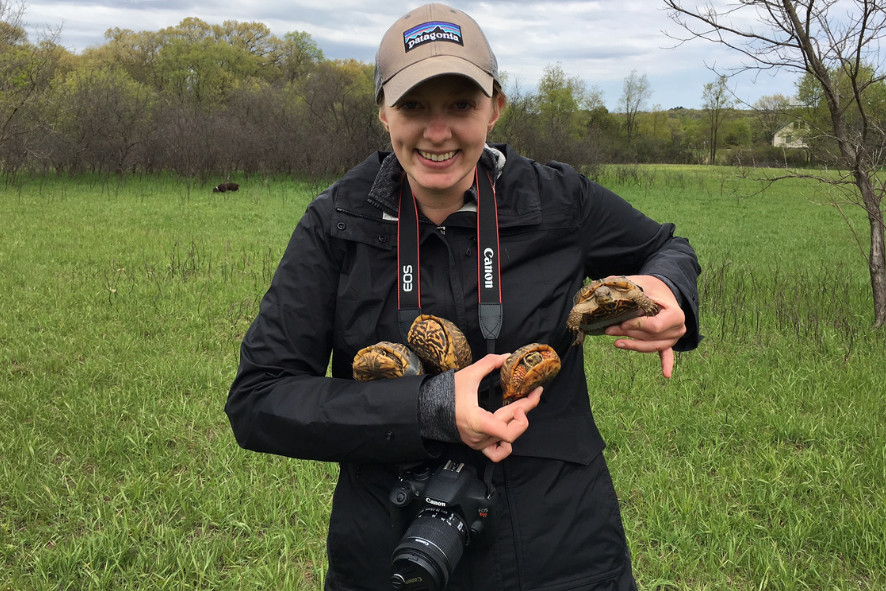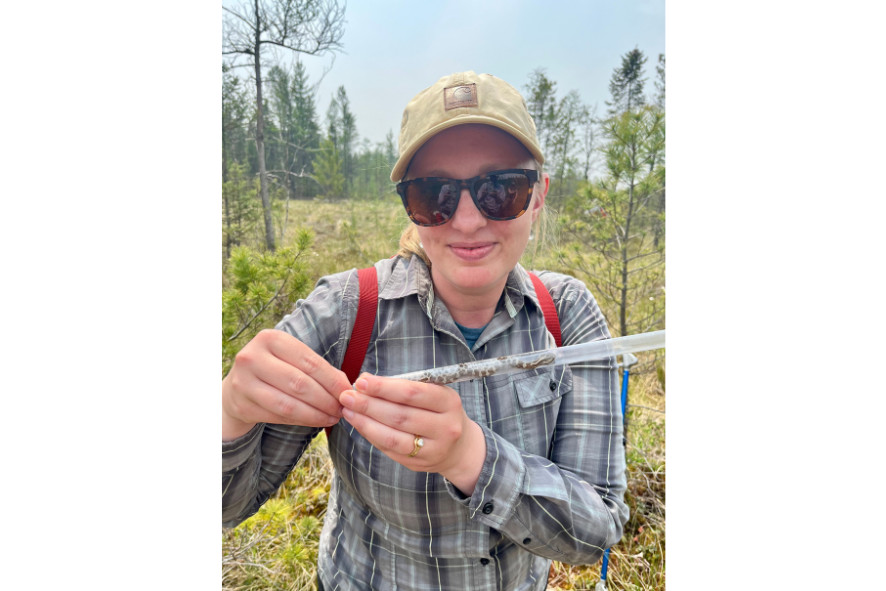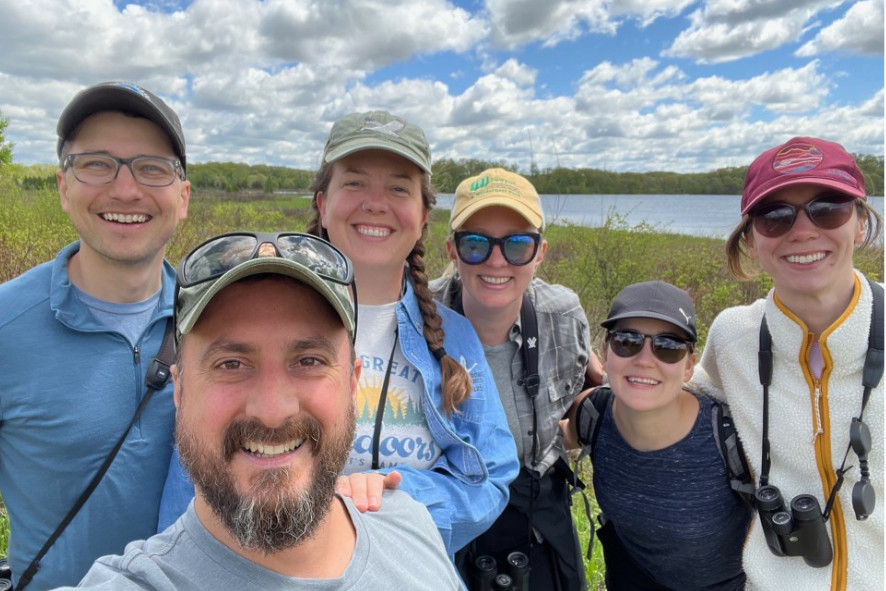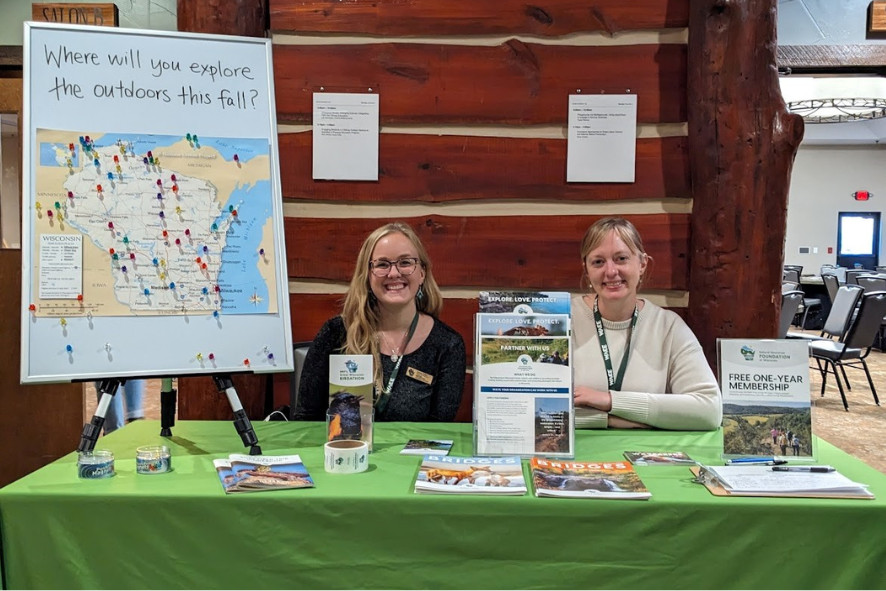Cait Williamson, NRF’s director of conservation, is celebrating 10 years working at the Foundation this year. Read her piece below reflecting on her time here at NRF and how the conservation department has transformed under her guidance.

Cait holding ornate box turtles. Photo courtesy of Cait Williamson
I laughed out loud when I recently came across one of my reflections from graduate school, which had prompted me to think about my future plans. My response read, “I anticipate continuing to work at the Natural Resources Foundation of Wisconsin for a couple of years, then moving on to another job in wildlife conservation.” That was 10 years ago. As they say, time flies when you’re having fun!
I reached my 10-year career milestone this year. I am incredibly grateful to have spent the last decade of my life working at NRF, where I’ve been able to build my dream job. As director of conservation, I get to put my knowledge, experience, and skill sets to good use. I work with an incredible group of passionate and talented colleagues and partners, and make a positive impact on our natural world. I lead NRF’s funding programs and initiatives that support our mission to protect Wisconsin’s lands, waters, and wildlife and engage diverse communities in conservation. My job is different every day. Some days, I am lucky enough to be out in the field visiting one of my project sites or attending a NRF Field Trip. Other days, I’m facilitating meetings with our conservation partners, designing projects, or doing outreach about our conservation efforts.

Cait holding a young massasauga rattlesnake. Photo courtesy of Cait Williamson
Since I joined, NRF has grown significantly as an organization, continuing to gain respect as a conservation funder and partner. Here are some of the milestones I’m most proud of over the past 10 years:
Doubling our conservation impact
When I started at NRF as grants administrator back in 2014, NRF distributed $375,000 per year to 100 projects. Today, we grant closer to $1 million a year to 200+ projects, more than doubling our impact. For the past decade, our grantmaking has been driving meaningful change for conservation in Wisconsin. Here’s how we’re making an impact:
- Restoring thousands of acres across critical landscapes
- Supporting recovery efforts for countless imperiled wildlife species
- Connecting thousands of children with hands-on, nature-based experiences
- Partnering with incredible conservation groups across the state
In the recent Living Planet report, research shows that the average size of wildlife populations has fallen by 73%. In Wisconsin, we’ve seen that impact firsthand, such as the rapid decline of monarch butterflies and other pollinators, major losses to bat populations from white-nose syndrome, and staggering losses of migratory birds. North America has lost one in four birds since 1970. NRF is focused on all of Wisconsin’s most imperiled wildlife species, and I’m proud of the efforts we’ve made to help recover them. For example, we’ve helped establish both the Wisconsin Monarch Collaborative and the SOS Save Our Songbirds initiative. Additionally, we’ve created the first-of-its-kind Wisconsin Amphibian and Reptile Conservation Fund. NRF is making a big difference for wildlife.

Great Wisconsin Birdathon proceeds support highest priority bird conservation needs, like SOS Save Our Songbirds. Cait (center) and friends participating in the 2024 Birdathon. Photo courtesy Cait Williamson
Prioritizing diversity, equity, and inclusion in conservation
In 2017, NRF began our DEI journey, acknowledging that the conservation field has not been diverse, equitable, or inclusive, and committing to help change that. Since then, we’ve created a Diversity in Conservation Internship Program which now has 30 alumni, supporting the next generation of conservationists. Additionally, we’ve established a DEIJ Community of Practice for our conservation partners. Also, we are focused on engaging diverse communities in conservation through our current strategic plan. I believe that we need an intersectional approach to conservation, one that encompasses both people and the planet. There’s still much more work to be done, but I’m proud of how far we’ve come as an organization. We’ve made it a priority to be authentic and intentional in our approach, ensuring equitable access to nature for everyone.
Addressing conservation’s large-scale problems with evidence-based approaches
A lot of factors are shaping the future of conservation—from climate change and society’s growing disconnection from nature to the rapid pace of global development. To tackle these challenges, we need conservation strategies that are more collaborative, large-scale, innovative, and evidenced-based than ever before.
Over the past 10 years, NRF has been intentional about working closely with our partners to stay up to date on the best available science. We’ve also incorporated tools such as the Conservation Standards, an international framework for conservation planning, which we used in our Driftless Conservation Plan. Additionally, the Northern Institute for Applied Climate Science’s Adaptation Workbook helps us consider the potential effects of climate change and design land management and conservation actions to prepare for changing conditions. This resource has been a key part of our recent projects including the Rush Creek Climate Adaptation Project.

DNR ecologists Amy Staffen (left) and Justin Nooker (center) with NRF’s director of conservation, Cait Williamson, at Rush Creek State Natural Area. Photo courtesy of Cait Williamson
At the end of the day, no matter how many tools you use, “conservation moves at the speed of trust.” Our focus on collaboration and building meaningful relationships with our partners is key. It is also important to have a holistic approach to conservation. We’re partnering with the Sokaogon Chippewa Community and Great Lakes Indian Fish & Wildlife Commission on wild rice recovery efforts at Spur Lake. We’ve also established collaborative groups like the Environmental Education Collaborative, Wisconsin Landscape Conservation Collaborative, and more. We want to bring people together and help to make a difference for Wisconsin’s lands, waters, and wildlife.

Lindsey Taylor and Cait Williamson at NRF’s table at the 2023 Midwest Environmental Education Conference. Photo courtesy of Cait Williamson
I would like to say a big thank you to all of the people I’ve worked with over the past 10 years. To my colleagues, partners, board members, and donors – you are what has made this such a special job. I’m looking forward to what the future holds and how we can have an impact on Wisconsin’s natural world together.
Together in conservation,
-Cait
Written by Caitlin Williamson, Director of Conservation